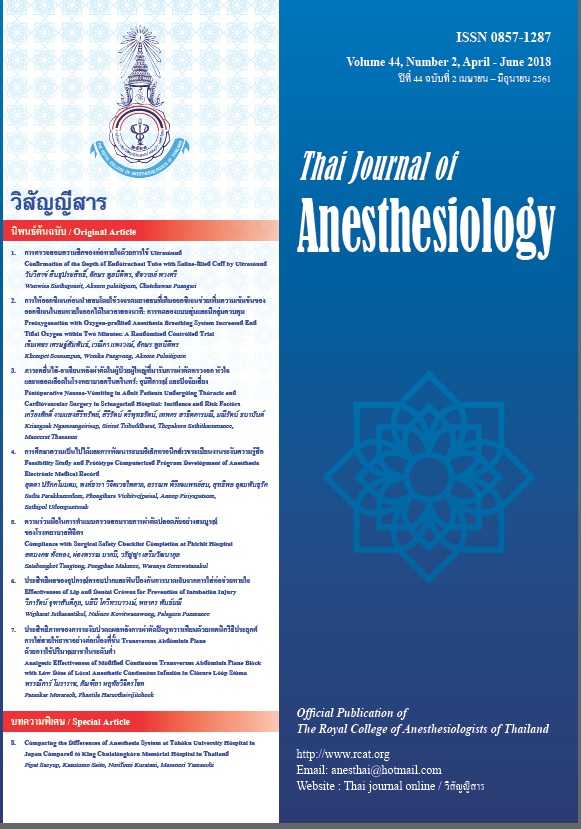Feasibility Study and Prototype Computerized Program Development of Anesthesia Electronic Medical Record
Main Article Content
Abstract
Introduction: An electronic medical record (EMR) is used not only to manage patient information but also to provide care service and perform job accountabilities. In addition, it yields comprehensive materials for clinical analysis.
Materials and Method: A prototype EMR including preoperative (AN01), intraoperative (AN02) and postoperative (AN03) events were developed and validated for its appropriateness. Target groups were thirty anesthesia personnel including 5 anesthesiologists, 5 for each 1st, 2nd and 3rd year residents; as well as nurse anesthetists and students. They all worked on 397 peri-operative patient data in virtual space. The fill-in anesthetic record was performed in a parallel manner via the EMR and a paper-pencil matter (PPR). Data were compared for its compliance using Cronbach’s alpha reliability and Mann-Whitney U test.
Results: The EMR was developed under C-sharp and ASP.net as windows and web application. Data migration was performed via Microsoft SQL-server using HL-7 as data transfer. The AN01, AN02, and AN03 showed its reliability of 0.73, 0.73 and 0.78 respectively. There were no significant differences of recorded data between the EMR and PPR.
Conclusion: The program showed its appropriateness for using in clinical anesthesia practice at the point of care.
Article Details
References
2. Ammenwerth E, Graber S, Herrmann G, Burkle T, Konig J. Evaluation of health information systems-problems and challenges. Int J Med Inform 2003; 71(2-3): 125-35.
3. Brender J. Evaluation of health information applications--
challenges ahead of us. Methods Inf Med 2006; 45(1): 62-6.
4. Wager KA, Ornstein SM, Jenkins RG. Perceived value of computer-based patient records among clinician users. MD Comput 1997; 14: 334-6, 338-40.
5. Peterfreund RA, Driscoll WD, Walsh JL, et al. Evaluation of a mandatory quality assurance data capture in anesthesia: a secure electronic system to capture quality assurance information linked to an automated anesthesia record. Anesth Analg 2011;112 (5):1218-25.
6. Avidan A, Weissman C. Record completeness and data concordance in an anesthesia information management system using context-sensitive mandatory data-entry fields. Int J Med Inform 2012; 81(3): 173-81.
7. Davis TC, Green JA, Colquhoun A, Hage BL, Biddle C. Anesthesia recordkeeping: accuracy of recall with computerized and manual entry recordkeeping. J Clin Monit Comp 2012; 26(3): 163-69.
8. LaDage T, Prasun M, Linton MJ, Kaiser A, Laskowski P. Nurse anesthetists’ perceptions of the electronic anesthesia information management system. Online J Nurs Inf [Internet] 2015 [cited 2017 Jan 20]; Available from: http://bit.ly/2FNqXjR
9. Piotrowski K. Reducing the barriers to electronic documentation in anesthesia practice settings. Online J Nurs Inf [Internet] 2012 [cited 2017 Jan 20]; 16. Available from: http://ojni.org/issues/? p=2003
10. Jang J, Yu SH, Kim CB, Moon Y, Kim S. The effects of an electronic medical record on the completeness of documentation in the anesthesia record. Int J Med Inf 2013; 82(8):702-7.


